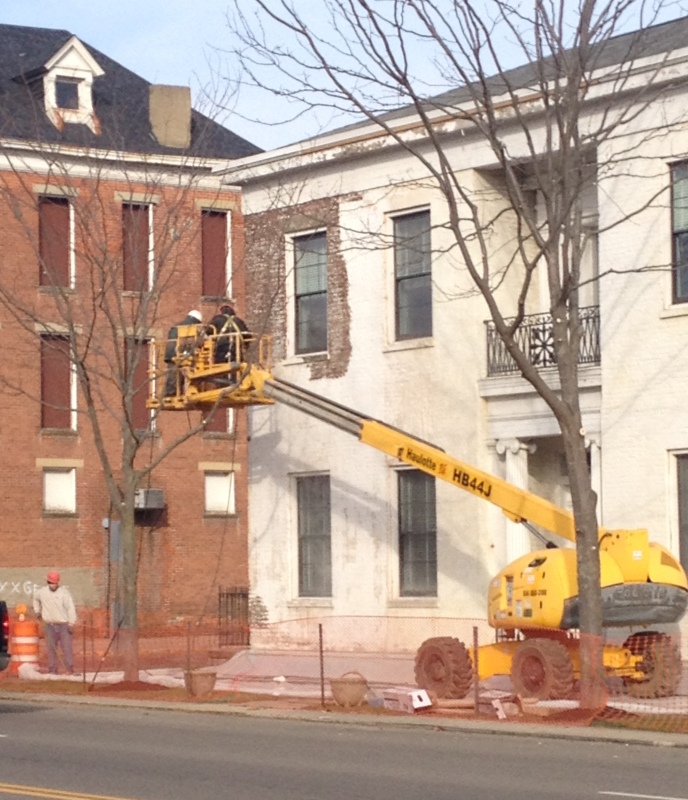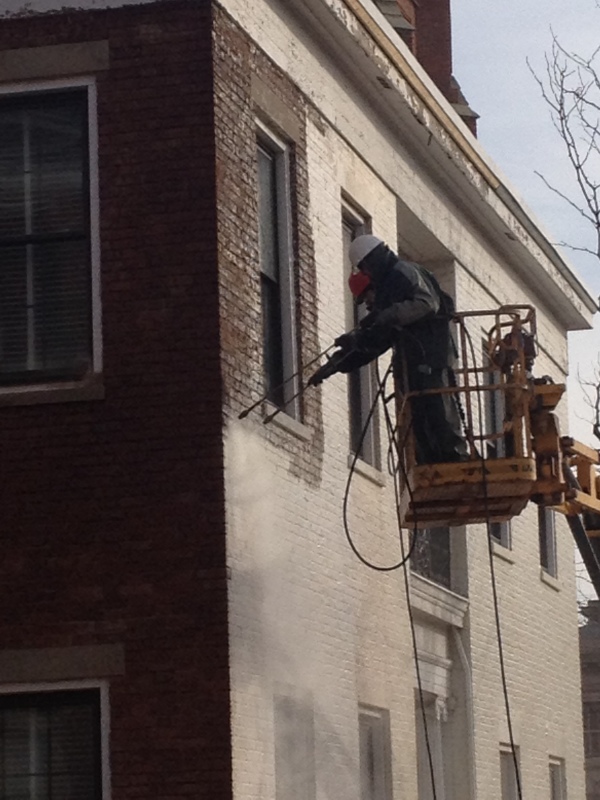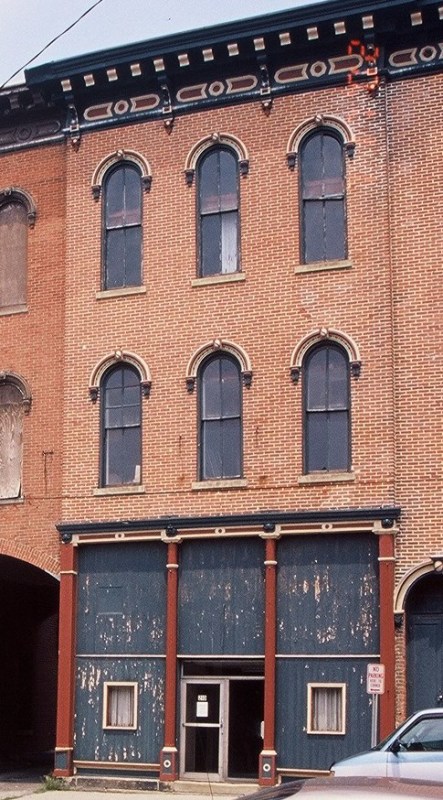Tuning up your vision statement
We’re winding up our evaluation season. Each year, we evaluate every Main Street program in Ohio using 10 different criteria. One of the items we review during each evaluation is the MS program’s mission and vision statement, reviewing its relevance, and sometimes making suggestions to tweak, or overhaul, if needed. Programs run the gamut of vision statements, but sometimes we run into confusion, because the local program isn’t exactly sure what makes a good vision statement.
Simply put, the vision and mission statements should pair nicely: the mission statement says what you want to accomplish, and the vision statement describes your district when you’ve accomplished that mission. Thankfully, we have a one-pager from Marc Smiley that provides some basics on what a good vision statement should look like. You can check it out here.
Here’s an example of a vision statement from Heritage Centre Association, the Main Street program in Mount Vernon: The Heritage Centre Association’s vision for Mount Vernon is a downtown brimming with activity in a beautiful setting with green spaces and well-preserved, lovingly restored, fully utilized historic buildings. It includes a thriving retail and restaurant district, ample parking and easy access to trails, waterways, and parks–a place where people of all ages come to shop, dine, work, and live. Residents and visitors alike can enjoy educational, arts, and cultural experiences and participate in a variety of community events. This vision includes thoughtful and generous involvement by community and business leaders and the support of a downtown organization with adequate, consistent funding and purposeful direction.

A good vision statement will literally paint the picture (with text) of what your revitalized district will look like when you’ve accomplished your mission.
Sometimes, the vision of what makes for a “revitalized” downtown can differ drastically from person to person, and organization to organization. In the example above, HCA has succinctly spelled out their vision for a revitalized downtown, and what it includes.
If you’re a fan of Marc Smiley as much as we are then you’ll be pleased to know we’re bringing Marc back to Ohio (specifically to Columbus) on May 19. Be sure to put the date on your calendar, and stay tuned to heritageohio.org for updates and registration information.
Update: registration for Marc Smiley’s workshop in Columbus has opened. You can register here.
Reasons to protest a National Register listing?
A Xenia newspaper recently reported on local efforts to list Xenia’s Carnegie Library in the National Register of Historic Places, an effort that has met with resistance from the owners of the building, the Greene County Commissioners. You can read the article here.
As you may know, National Register listing typically conveys a couple benefits on the owner of the listed building: a measure of pride and satisfaction at receiving recognition of the building’s historic status (typically for owners of residential properties), or access to redevelopment incentives (for owners of commercial rental property). National Register listing can also assist in efforts to preserve a historic building against unwanted federal intrusions, or when federal money is used (commonly referred to as the Section 106 process).
When it comes to National Register listing, there are only benefits, not restrictions. In fact, an owner can have his or her building listed one day, and tear it down the next day. We still occasionally hear the myth that National Register listing entails restrictions, when someone is protesting National Register listing (we got a little into NR myths and misinformation after Barb Powers excellent conference session here). And when it comes to redevelopment of historic buildings, we recommend National Register listing, even if the owner has no intention of investing in the building’s rehabilitation. A developer looking to rehabilitate a historic building has cleared an important hurdle when purchasing a building already listed in the National Register.
In a letter to the State Historic Preservation Office, the county administrator stated that the county commissioners didn’t see a benefit to listing, nor was he sure about the compatibility of an elevator within a historic space (his written comments, according to the article: All the history, does an elevator marry well with the history.)
The administrator goes on to state that while he understands there’s no barrier to demolition, once a building is listed, he doesn’t want the barrier (?) of National Register listing in place should the commissioners decide ultimately to demolish.
While the county commissioners, and administrator, don’t see the benefit of listing, I’d encourage them not to stand in the way of listing, especially when it’s been completed at no (or very minimal) cost to the county by volunteers. It can only improve the marketability of the building, when the commissioners do decide to sell.
3 signs your contractor is doing more harm than good to your masonry building
We learn early on in the preservation field about the dangers of abrasive “cleaning” on old masonry. Heck, it’s even immortalized in the Secretary’s standards, saying, “Chemical or physical treatments, if appropriate, will be undertaken using the GENTLEST means possible (my emphasis). Treatments that cause damage to historic materials will not be used.” (What’s that? You’d like a refresher on the other 9 standards? OK, you can check ’em out here.)
I like to refer to this as the sandblasting standard; in other words, don’t do it! When it comes to masonry, don’t blast it. Don’t blast with sand, water, walnut shells, ice pellets, or anything else that comes out of a heavy rubber hose at high pressure. Just don’t.
Sometimes I forget that not everyone who owns an old, historic masonry building has learned this important lesson, so I’m asking you today, dear reader, to help us get the message out. Let design review boards, preservation groups, owners of brick buildings, and anyone else who could benefit from the knowledge, know that blasting historic masonry is just plain bad.
Meanwhile, I’ll share with you my unfortunate experience I had the other day, and some signs that the masonry contractor is doing more harm than good to your building.
1. Fast paint removal
I’ve always thought of any construction project as having three pillars of output: time, price, and quality. Of course, every owner wishes to have the project done quickly, cheaply, and of high quality. But in this case, two out of three is perfection. You can’t have all three, so you have to decide which two you’re going to focus on (might I suggest high quality as one of the two).
This means that if you want something done quickly and to high quality, you’ll pay the price. If you want something done cheaply and to high quality, you can bet it will take a long time to get the project finished (if you can even pair up price and quality to begin with). And if you want something done quickly and cheaply, you’ll likely pay for it with a low quality job.
In this case, beware the contractor who offers “fast” paint removal from brick. The only way you’ll get fast paint removal from brick is at the cost of compromising the very integrity of your masonry. This is where blasting brick to remove paint comes in. Blasting brick is a great way to remove paint “fast.” What it does to the brick? Not so great.
2. Brick valleys
Masonry, even the old “soft” brick is a pretty smooth building material. It doesn’t have ridges and valleys, like what we see here, once the damage has been done.
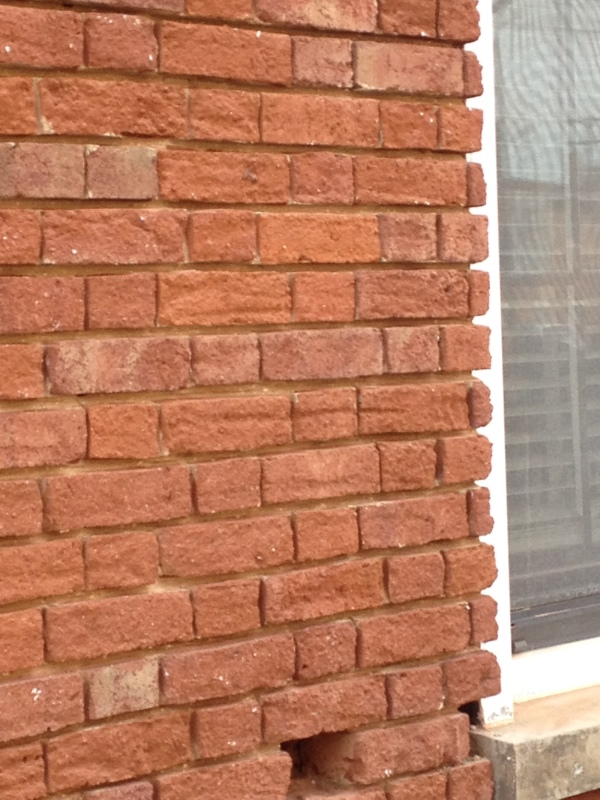
They had the blaster set to “destroy” for this job. Notice how the horizontal lines extend along the same level, from one brick to another? This was caused by the blasting material (in this case, water), the proximity of the tool to the surface (too close), and the pressure of the blasting.
When the hard outer shell of the brick has been removed, you’re left with a much softer interior. Soft interiors+freeze/thaw cycles=bad news. But, while the structural integrity of the brick has been compromised, at least the paint’s gone!
3. Nozzles and brick: up close and personal
Now, it’s not that we frown upon anything harsher than cotton balls dipped in warm water, delicately rubbed back in forth in a gentle, circular motion, to cure what ills your brick. It’s just that there’s this wide gulf of possibility between too gentle and too harsh. Yes, you can loosen flaking paint with water jets. But, you have to be careful that the pressure setting won’t harm your brick. You also have to be mindful that water, as the sworn enemy of historic buildings, will do bad things if it gets into the building. And, even a low setting too close to the wall can be bad for your brick. A high setting too close to the wall is more like fatal for your brick.
As preservationists, we should all savor the opportunities to educate people about the wonderful assets they have, and that the care and maintenance of elderly buildings is best left to restoration professionals.
Cincinnati's Music Hall receives catalytic tax credit award
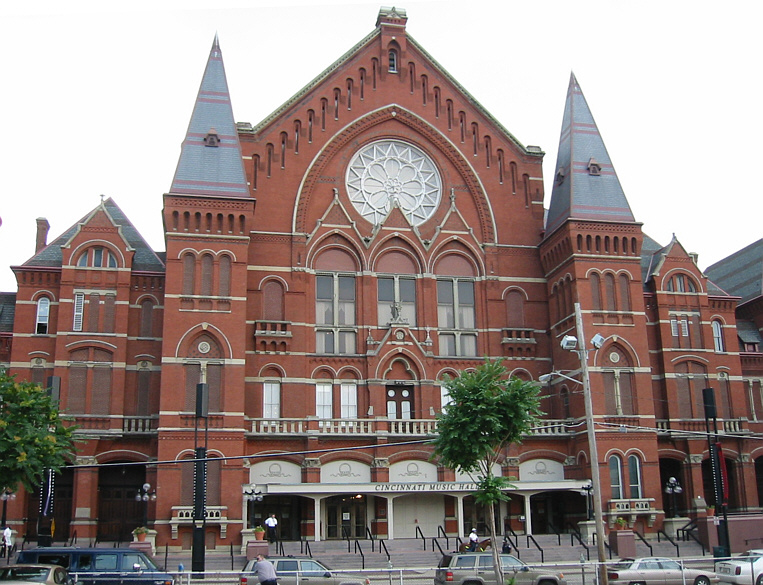
Attribution: http://en.wikipedia.org/wiki/Samuel_Hannaford#mediaviewer/File:Cincinnati_Music_Hall_2002a.jpg
Music Hall in Cincinnati was the big winner in the latest round of tax credit awards named yesterday. You can read more from ODSA’s press release here.
The 10% (residential) tax credit…no, really! Pt II
We left off with my promise to share what I found out about the 10% tax credit, and just what you could or couldn’t do with it when it comes residential rehabilitation.
I started by checking out Form 3468 from the IRS, the form you attach to your return (you can view a PDF of the form here). One definite advantage to the 10% credit is the fact that there’s no 3-part process involving the SHPO, the National Park Service, the IRS, and your raft of consultants (depending on the complexity of your project). You report your 10% credit on a three-page form that you include in your annual return. And really, it’s one line multiplying your Qualified Rehabilitation Expenditures by 10%, and entering that total on the last line of the form.
In consulting the 2013 Instructions for Form 3468 (which you can find here) because nothing with the IRS is as easy as writing the total in one line, we learn that the Qualified Rehabilitation Expenditures have to be for “nonresidential rental property.” So what exactly does that mean? Sorry, the IRS can’t be bothered with including definitions for common terms used on the form. That would be…helpful.
However; undaunted, and hot on the trail of this mystery, I google “nonresidential rental property definition” and then I google “residential rental property definition” which brings me to the next IRS publication. IRS Publication 527 covers residential rental property (yep, I’ve got your link for it here) and the IRS gets into property classes. While the classes don’t include “nonresidential rental property,” we do get a definition for “residential rental property” as follows:
This class includes any real property that is a rental building or structure (including a mobile home) for which 80% or more of the gross rental income for the tax year is from
dwelling units….
So, does that mean the inverse applies for the definition of nonresidential rental property? As long as less than 80% of your income comes from dwelling units, is your property defined as nonresidential rental property in the eyes of the IRS? I kept searching.
A fair amount of googling later, I came upon IRS Publication 946, which delves into property depreciation (you glutton…here you go) and the good folks at the IRS included a glossary in the publication. Their definition for residential rental property (sorry, nothing under the Ns for nonresidential rental property) is:
Real property, generally buildings or structures, if 80% or more of its annual gross rental income is from dwelling units.
So, again, do we flip greater than 80% for less than 80% to come to the definition of nonresidential rental property? And, anyway, why should we really care?
And the answer is that there is a lot of potential for the renovation of old, mixed-use commercial buildings, 2- 3- or 4-story, that could use the 10% rehab tax credit, but that don’t, leaving serious incentive money on the table. According to the IRS, as long as less than 80% of your income comes from the residential portion of your building, the IRS categorizes it as nonresidential rental property, and appears to be eligible for the 10% tax credit. And on a $100,000 rehab project, that’s an extra $10,000 in the developer’s pocket at the end. Not bad for filling out a couple lines on your tax return.
Now, since I’m not a lawyer or tax advisor, I’m afraid all I can do is whip you into a frenzy over incentive dollars you could be taking advantage of (or did all the IRS publications already do that?) so please don’t take this as a substitute for consulting your own favorite tax person or lawyer.
If you have your own two cents, or 10%, to contribute to the conversation, I’d love to hear from you. Have you successfully taken the 10% credit on a project with a residential component? Have you uncovered that elusive definition of nonresidential rental property that you would be willing to share? Thanks for reading!
The 10% (residential) tax credit…no, really! Pt I
Every good preservationist knows that rehab tax credits get subdivided into two neat categories: the 20% credit for the rehab of National Register-listed buildings, and the 10% credit for the rehab of non-NR properties constructed before 1936. Every good preservationist also knows that the 10% credit can only go toward buildings with non-residential uses (it says so in the Historic Preservation Tax Incentives brochure that you can check out here).
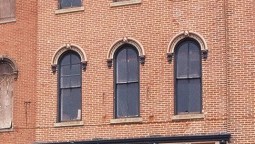
What if you could use the 10% tax credit on redevelopment projects that included a residential component?
As someone who likes to consider myself somewhat well-versed in the rehab tax credits, you can imagine my surprise when my Historic Real Estate Finance instructor asserted that, in fact, you could use the 10% credit for a project that included a residential component. I remember thinking at the time that that was a good piece of tax credit info to know, and I filed it away in my mind.
Fast forward to yesterday, and Joyce and I were having a conversation with a developer who is redeveloping a non-NR building, constructed before 1936, for mixed use.
So, I bring up the 10% tax credit. The developer would use the 10%, but the building development will have a residential component…and then I pounce.
Well yes, but, did you know you *can* use the 10% on a mixed use project with residential?
However, after piquing the developer’s interest, I realize I can’t exactly defend my position with official IRS definitions, or publication references proving my point. So, I tasked myself with a mini-IRS immersion to first and foremost conclusively prove (at least to myself) that I’m providing useful information a building developer will actually be able to use.
I’ll share my search for definitive answers (and the results) in Part II.
Our Town grant announcement
The National Endowment for the Arts has announced its latest round of funding for its Our Town initiative. Eligible activities include Arts Engagement, Cultural Planning, or Design. Prior grant recipients in Ohio have included: Westcott House Foundation in Springfield (2014), Pomerene Center for the Arts in Coshocton (2013), Detroit Shoreway in Cleveland (2012), Art Opportunities in Cincinnati (2012), and Artspace in Hamilton (2011), so the NEA is familiar with Our Town projects in Ohio.
An initial online application submitted through Grants.gov is due by December 15, 2014. For more information, click here to access the Our Town Grant information page.
We need more myth-busting!
I’m curious: did you happen to catch Barb Powers’ presentation at our Annual Conference in Kent, Myth-Busting the National Register of Historic Places? If not, here’s the quick (very quick!) summary: myths and misinformation abound when it comes to the National Register of Historic Places, including what owners of buildings are or are not required to do with their NR-listed property.
Combating that misinformation and trying to set the record straight seems to be one of those perpetual tasks for organizations such as the SHPO and Heritage Ohio. I was just reminded this week of the ignorance being spread about the National Register when I was reading an article about Hamilton’s efforts to list their downtown in the National Register in order to access tax credit incentives (you can read the article here). While the article is factually correct, the problems happen when we get to the comments section, specifically the commenter saying “Registration prevents revitalization and requires preservation. This is a bad move… You cannot change the exterior of registered buildings. You cannot demolish older buildings to replace them with newer buildings. You can maintain a movie set for the early 20th century. But, you kill revitalization of the city when you register the buildings.”
Of course, anyone who attended Barb’s session, or who has a basic familiarity with the National Register understands that these comments are patently false. The National Register does not require building owners to preserve their buildings. Nor does it prohibit exterior changes. Nor does it prohibit demolition. Unfortunately, these voices are out there, they crop up, and they have their believers. So, our jobs, as passionate preservationists, is to make sure we take every opportunity to educate people about what the National Register does and does not do, and refute National Register ignorance when we have the opportunity.
Ten truths of Smiley Pt II
I hope you had a chance to read the first post highlighting the Ten truths of Smiley. While not an exhaustive list, these were some of the concepts Marc presented at the June training in Marietta that struck a chord with me. I think that organizations keeping these “truths” in mind as they go about their mission-based work have a better chance of achieving their goals. We looked at 1-5 a couple days ago, and today we’re looking at 6-10.
6) The easy thing to do is grab people and put them on your board; the right thing to do is to approach board recruitment from a strategic standpoint.
Is there a secret to the success of highly effective organizations and the boards that run them? If there is, it certainly has something to do with the skills and knowledge of the people representing the board, and how those skills and knowledge uniquely assist the organization.
The board profile grid (something Marc is happy to share a sample of here) is a development tool that, when put into place and practiced, can become an “A-ha!” moment as board representatives realize for the first time that strategic development and recruitment of the board can propel an organization so much farther than simply trying to fill a board room with warm bodies. Every organization has unique skills it needs in order to accomplish its mission, and creating a customized board grid helps everyone understand what skills the current board brings to the table, and helps to narrow the focus for recruitment of new board members.
Marc shared a simple but brilliant device for keeping the board process in mind: R-O-T-E-R. A successful organization is careful to Recruit, Orient, Train, Evaluate, and Recognize their board.
7) When I say “board orientation,” do you say “What board orientation?”
Board orientation: it’s another one of those un-sexy but critical practices of successful organizations. In our years of working with local preservation organizations, and downtown revitalization organizations, we usually seem to encounter passionate people working on the external issues facing the community, but sometimes to the detriment of nurturing and building the internal foundation of the organization.
Have you ever been involved with an organization where you accepted a leadership role (such as serving on the board of directors) with vague promises from the board chair or the perpetually harried executive director to get you a full packet of board member materials, only to have little bits and pieces dribble in over the course of the first few meetings? (Forget the bylaws, I’d just be happy with a list of your passed motions from the last 12 months!) Making time to 1) put together a professional looking board orientation/board manual packet, and 2) sitting down with the prospective or new board member to share an organizational overview is not only a critical part of strengthening that board/stakeholder relationship, but making sure everyone is on the same page from the start. If you’re not sure what typically goes into a board member orientation packet, we can provide examples and share the important concepts we think a good orientation piece covers.
8) Good committee chairs: where do they hide???
If you were to ask whether someone would rather suffer from the occasional spontaneous bout of explosive diarrhea for the rest of their life or serve as the chair of the local Main Street program’s Economic Restructuring Committee for the next two years, I really think 99% of the people asked would politely pass on the chairmanship. So, lucky you, you’re on the hunt for that elusive 1% willing to serve as a committee chair.
While there’s no super secret rock that committee chairs-in-waiting hide under, there are things you can do to better set your organization up for success. Formalize the leadership cycle. Elect 2 vice chairs to serve staggered terms so there’s always overlap (and someone to share the occasional frustration). Or maintain committees with immediate past chair, current chair, and chair-elect as active committee members.
Sometimes it pays to be sneaky! Marc suggested this leadership recruitment trick: ask your prospect “Will you be the chair next year?” It always seems easier to commit to something in the future, and once you have the commitment, the hope is that your future chair will follow through when the time comes.
9) How well do you know your supporters and how well do they know you?
Over the course of my adult life I’ve had the experience of happily joining a nonprofit organization, strongly believing in their mission, only to become disillusioned a couple years in, because I would hear from them just once a year, when it came time to send my check in for my membership renewal. There was a lost opportunity to strengthen the donor/organization relationship, because there was no two-way relationship building: I wasn’t learning more about them and they weren’t learning more about me, and they lost my membership because of it.
As an organization, you have a great opportunity to tout yourself, but also to learn more about the people who believe in your work so explicitly that they financially support you. Welcoming someone with a new member packet, actually asking the “Why do you support us?” question, sending them a card on their birthday to let them know they’re important and that you care about their relationship with you, can all go a long way toward strengthening the member/organization bonds.
10) Last but not least: People have time to give, they do not have time to waste.
Volunteers are the lifeblood of your organization. Treat their volunteer time as the sacred gift it is. That means: no more meetings for the sake of having a meeting; no more meetings where the time is spent rehashing the discussion from last month’s meeting; no more board meetings where board members try to do the committees’ work; and no more meetings lasting more than two hours.
I hope you’ve enjoyed reviewing some of Marc’s top truths when it comes to organizational excellence. How will you know when you’ve really made it as an organization? In the words of Marc, it’s when people quit other boards in order to have the experience and privilege of serving on your board.
Ten truths of Smiley Pt I
We were pleased to host organizational guru Marc Smiley at our June Revitalization Training in Marietta (thank you to Marietta Main Street for being great hosts!) Marc did not disappoint as he spent the day clarifying organizational concepts, answering attendees’ questions, and providing humorous anecdotes. If you didn’t get the chance to attend, I’ve compiled some highlights, or truths, that Marc conveyed, for you to use in your day-to-day operations. We’ll go through 1-5 today, and then pick up 6-10 in a couple days.
1) The best organizations build relationships with their stakeholders over time.
How many times have you witnessed (or even worse, been a part of) an organization offering a board seat to an individual who has just recently joined an organization? Some organizations put out such a desperate vibe for board members (or other important leadership positions) that it seems their only qualifications for board service include a pulse and the ability to recite the name of the organization upon request. While the kind-hearted nature of the typical community volunteer means they feel part pity, part embarrassment at being asked, and part desire to help improve the culture of the organization, what begins with good intentions may not end with as good of results.
An organization moving its volunteers through deliberate phases (member, event volunteer, committee member, board member, organizational leader) gives both the organization and the volunteer a chance to get to know one another before either makes a big commitment in the relationship. When both sides have a better idea of what to expect from the other, the chances of burnout, frustration, and unpleasant surprises are lessened.
2) Neither the board or staff are islands unto themselves when it comes to raising money.
When it comes to fundraising, especially when looking at bigger donors, there are a bunch of tasks, from developing the “ask” materials, to prospecting for donors, to establishing and developing the donor/organization relationship, to making the ask, to stewarding the donor “post” ask. And any organization that does a good job of fundraising understands how those tasks are distributed among staff and board. The board cannot drop the job of fundraising into the executive director’s lap, nor can the executive staff put up its hands and expect the board to handle 100% of the fundraising tasks just because fiduciary responsibility sits squarely with the board.
3) Fear of raising money is not an excuse not to raise money.
Sometimes an organization develops the “woe is us” collective mentality, coupled with an intense fear of active fundraising to make things happen. You know the organization: they’re figuratively clanking their tin cup while sitting on the sidewalk, in the hopes that a kind soul will pass by, take pity on the group, and drop a few coins into their cup.
Organizations suffering from their own inferiority complex have two options: go for the extreme makeover, convincing themselves first, and then everyone else, that they play an important role in improving the community in which they are located. They take every opportunity to tout the good work they do, and to continually make the argument that they do what the public sector can’t do, or what the for-profit sector does not want to do. They demonstrate that donors giving to their organization will see returns on their giving, and do their best to insure that stakeholders are delighted to be involved with their mission-based work.
The other option? Let that fundraising fear paralyze the organization until their relevance within their sphere of work drops to a negligible level and the organization has to close its doors for good. (I promise: I’m not trying to write a “scared straight” post here.)
4) Understanding what is important, and what is urgent, and giving each its proper attention, is key.
This is where good planning habits come into play. Organizations that balance the approach of short-term and long-term planning are able to address not only the fires that have to be put out today (those decidedly un-sexy conversations about the ideal placement for outdoor trash receptacles), but the grand visions that, once accomplished, cause people to look directly into one another’s eyes, mouths agape, and say “Did we really just hold a ribbon cutting on that white elephant building that had been vacant for 25 years???”
It’s too easy, when we’re strictly focused on today, to forget to put our mission into the context of what we’re supposed to be accomplishing 20 years from now, just like it’s hard to tackle today’s problems when all we can focus on are the big-fix needs in our community. A good organization finds the balance between devoting resources to today’s urgent and tomorrow’s important, keeping both in mind.
5) Job descriptions for everyone!
No really, everyone needs a job description. OK, I sense those rolling eyes, and that sarcastic thought “Hooray, more busy work for me while I watch my community go to hell in a handbasket.”
But when it comes to getting off on the right foot, stakeholder to organization, there’s nothing better than shared expectations, transparency in expectations, and everyone being on the same page with what exactly those expectations comprise. And, one of the best ways to institutionalize that foundation is through a job description outlining function(s) within the job, responsibilities, and expectations.
Don’t fret if you’re involved in an organization totally lacking in job descriptions. We have many examples we’re happy to share as templates for you, as does Marc Smiley, here. See? Not that bad.
Anyway, we’ve covered 1-5. I hope you’ll join me in a couple days for the rest of the best, courtesy of Marc Smiley.
Mentoring visits
Last week, Jeff and I had the opportunity to visit the preservation statewides in Indiana and Michigan—Indiana Landmarks and Michigan Historic Preservation Network. We were able to travel thanks to a grant from the National Trust for Historic Preservation, through its Brink Fund. This fund provides mentoring dollars to cover travel costs so preservation organizations such as Heritage Ohio can learn about successful programs in other states.
For Heritage Ohio, we’ve established our Save Ohio’s Treasures program with seed funding from the Turner Foundation and from the 1772 Foundation, and we’re in the “gathering information” phase. Visits to neighboring statewides will help prepare us as we investigate how best to create and formally launch Save Ohio’s Treasures.
In many ways, Indiana has the statewide organization that many other statewides aspire to become. With a multi-use headquarters, 40+ full-time staff stationed throughout the state, and an endangered fund program that has saved hundreds of historic buildings over the fund’s 40 years of existence, Indiana Landmarks shows what top-notch staff paired with generous donors can achieve. Their Efroymson Family Endangered Places Fund operates throughout the state, and Landmarks uses fund dollars to make strategic investments.
Michigan’s statewide has taken an innovative approach to raising funds by creating a subsidiary company to serve as a tax credit syndicator. They have used the fees generated from syndicating to capitalize their Intervention Loan Fund.
While their respective programs represent different ends of the endangered properties fund spectrum, we came away with critical insights from each that we can apply to our unique situation in Ohio. Here are some of the highlights of what we learned:
-Mission-related investments, unlike business-related investments, aren’t necessarily designed as much to make money as they are to save buildings (hence, we may invest in a project to save a building, when we know from the start that we’ll lose a portion of that investment)
-Making grants from an endangered fund, while attractive to the recipient, mean that once the money is disbursed, it’s gone, while loans from a fund (theoretically) come back to the fund and replenish the fund, making fund dollars go further
-Accepting program dollars with strings attached, when raising funds to build the corpus of the endangered places fund, may be ok (depending on what those strings are)
-It’s critical to think through the approach of how funds are loaned: do you spread a lot of minimal dollar amounts, or do you target larger dollar amounts for focused efforts, at the expense of overall impact
-It’s also critical to establish benchmarks about just how “historic” a building has to be to qualify for funding help (for example, should we consider strategic investment to help preserve properties not listed in the National Register of Historic Places?)
It has been exciting to work on building Save Ohio’s Treasures from the ground up for us, especially since we see the need and the potential for a fund devoted to helping to save our heritage.
As we sift through these important topics, we’re working with a team of consultants to complete an implementation plan toward the end of the year. We’ll take the lessons learned and insights gained from Indiana and Michigan to help us create a plan that sets up Save Ohio’s Treasures for success.
My intense week of learning
In June I was in Newport, Rhode Island, on the campus of Salve Regina University, to complete the second part of the Historic Real Estate Finance class put on by the National Development Council, with support from the 1772 Foundation and the National Trust for Historic Preservation (you can see pretty pictures of the Newport homes here and here).
The first class was intense. We spent the week learning developer math (calculating debt service, net operating income, market caps, and debt coverage ratios), cranking out pro forma sheets for actual projects, and plugging incentives such as the rehabilitation tax credits into project problems. What we learned early on as a class is that development, especially when it comes to historic buildings, carries a great deal of risk. While one project that goes right means positive cash flow to a developer, a project that goes wrong can put a developer under.
We also learned that revenues post-rehabilitation rarely match expenses going in pre-rehabilitation; hence, the need for incentives to help close the financing gap.
The first class was intense. The second class was brain damage, as the instructors mixed the math and story problems with a generous helping of New Markets Tax Credits learning (although, to the instructors’ credit, I left this class truly understanding, for the first time, how NMTCs work and why they can be so powerful to make projects go) *and* case studies that took problem solving to new heights of depth and complexity. (Here’s Dartmoor. I had an especially good time with the Dartmoor case study, as we tried to translate subjective qualities of the players into objective dollars and cents outputs.)
Going through these two classes, I have a new-found appreciation for the tough job of being a developer of historic properties, no matter how big or small the project, and just how big a risk people take sometimes to preserve the heritage that makes all of our lives richer for having it. Thank you to the National Development Council, the 1772 Foundation, and the National Trust for Historic Preservation, for making such a valuable learning experience accessible, challenging, and thoroughly enjoyable!



